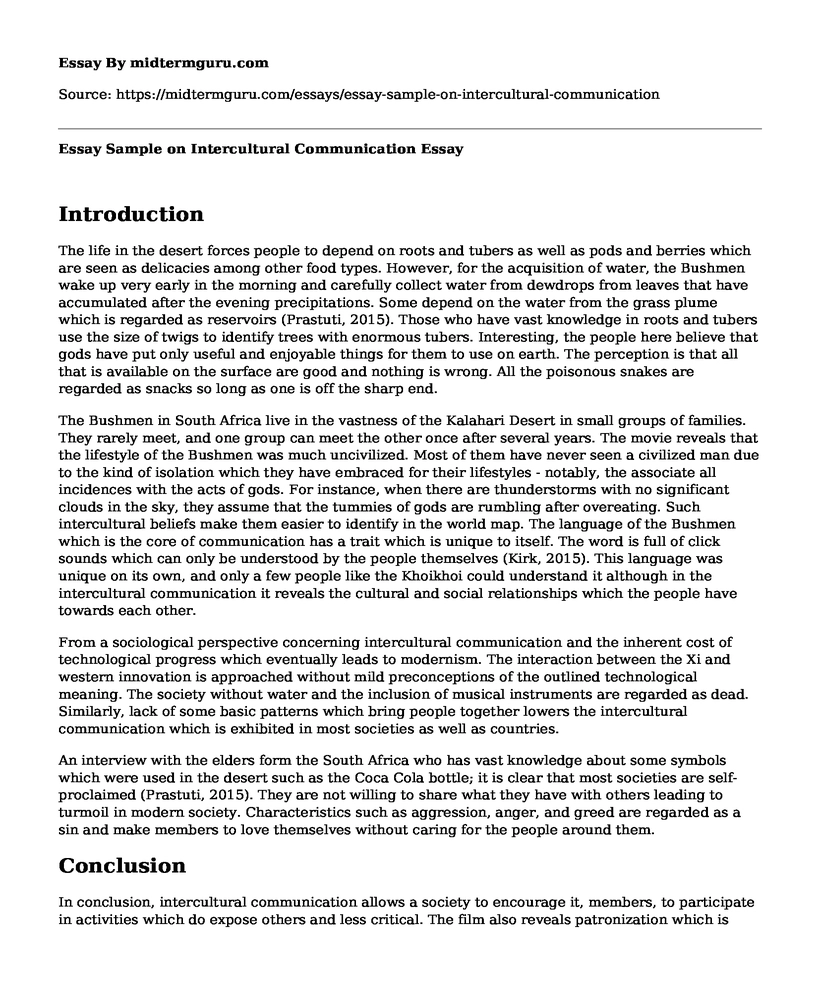Introduction
The life in the desert forces people to depend on roots and tubers as well as pods and berries which are seen as delicacies among other food types. However, for the acquisition of water, the Bushmen wake up very early in the morning and carefully collect water from dewdrops from leaves that have accumulated after the evening precipitations. Some depend on the water from the grass plume which is regarded as reservoirs (Prastuti, 2015). Those who have vast knowledge in roots and tubers use the size of twigs to identify trees with enormous tubers. Interesting, the people here believe that gods have put only useful and enjoyable things for them to use on earth. The perception is that all that is available on the surface are good and nothing is wrong. All the poisonous snakes are regarded as snacks so long as one is off the sharp end.
The Bushmen in South Africa live in the vastness of the Kalahari Desert in small groups of families. They rarely meet, and one group can meet the other once after several years. The movie reveals that the lifestyle of the Bushmen was much uncivilized. Most of them have never seen a civilized man due to the kind of isolation which they have embraced for their lifestyles - notably, the associate all incidences with the acts of gods. For instance, when there are thunderstorms with no significant clouds in the sky, they assume that the tummies of gods are rumbling after overeating. Such intercultural beliefs make them easier to identify in the world map. The language of the Bushmen which is the core of communication has a trait which is unique to itself. The word is full of click sounds which can only be understood by the people themselves (Kirk, 2015). This language was unique on its own, and only a few people like the Khoikhoi could understand it although in the intercultural communication it reveals the cultural and social relationships which the people have towards each other.
From a sociological perspective concerning intercultural communication and the inherent cost of technological progress which eventually leads to modernism. The interaction between the Xi and western innovation is approached without mild preconceptions of the outlined technological meaning. The society without water and the inclusion of musical instruments are regarded as dead. Similarly, lack of some basic patterns which bring people together lowers the intercultural communication which is exhibited in most societies as well as countries.
An interview with the elders form the South Africa who has vast knowledge about some symbols which were used in the desert such as the Coca Cola bottle; it is clear that most societies are self-proclaimed (Prastuti, 2015). They are not willing to share what they have with others leading to turmoil in modern society. Characteristics such as aggression, anger, and greed are regarded as a sin and make members to love themselves without caring for the people around them.
Conclusion
In conclusion, intercultural communication allows a society to encourage it, members, to participate in activities which do expose others and less critical. The film also reveals patronization which is common among the black people although it is painfully gendered. The cultural value which is associated with possession is power. The individual who makes up a comprehensive intercultural communication in a country varies and come from a wide range of ethnicity, education, religion, and economic background. However, intercultural communication aims to understand the nature of the relationship which individuals have in different cultures and countries and which they perceive or share with the world around them. Overall, the inherent cultural value of possession is regarded as the only important theme which is underlined in the movie. It portrays the Xi's tribes about the Bushmen life in the Kalahari Desert which is one of the dry areas in Africa. However, despite all the challenges which these people face, they are very optimistic and cherish everything that the gods are responsible for them.
References
Kirk, F. (2015). Troubled vision: Interrogating the visual protocols of 20 the century ethnographic literary and cinematic travelogues. Michigan State University.
Prastuti, R. A. (2015). An analysis of commissive utterances in the film entitled "the Gods must be crazy" and its implication on teaching speaking (Doctoral dissertation, Universitas Sebelas Maret). Retrieved from https://eprints.uns.ac.id/id/eprint/19802
Cite this page
Essay Sample on Intercultural Communication. (2022, Oct 05). Retrieved from https://midtermguru.com/essays/essay-sample-on-intercultural-communication
If you are the original author of this essay and no longer wish to have it published on the midtermguru.com website, please click below to request its removal:
- Essay Sample on How the Society Views the Gender
- Interactive Communication Model - Essay Sample
- HR Management Essay on Outsourcing: Diversity and Multiculturalism
- Effective Listening: The Key to Effective Communication - Essay Sample
- International Expansion to Canada: Social and Cultural Risks - Essay Sample
- Equal and Fair Treatment: Cornerstone of the Workplace - Essay Sample
- Family Get-Together: Celebrating Credibility & Purpose - Essay Sample







